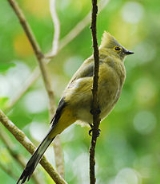
Long-tailed Silky-flycatcher
Encyclopedia
The Long-tailed Silky-flycatcher, Ptilogonys caudatus, is a passerine
bird
which occurs only in the mountains of Costa Rica
and western Panama
, usually from 1,850 m altitude to the timberline. It is a thrush-sized
species weighing about 37 g. The silky-flycatcher
s are related to waxwing
s, and like that group have a soft silky plumage.
The habitat of this bird is mountain forests, where the breeding pair builds a neat cup of lichen
2–18 m high in a tree, sometimes in loose colonies. The female lays two brown and lilac-blotched grey eggs, which are incubated by both adults. The young fledge 18–25 days after hatching, and are fed by both parents.
The male Long-tailed Silky-flycatcher is 24 cm long and has a pale grey forehead. The rest of the crested head, neck, throat and lower belly are yellow. The back, lower breast and upper belly are blue-grey, and the flight feathers and long pointed tail are black. The outer tail feathers are spotted with white.
The female is 21 cm long and generally duller than the male, with a darker grey forehead, olive body plumage and a shorter, duller black tail. Immatures are similar to the adults, but the central tail feathers are shorter and the white spotting on the outer tail is indistinct.
This species forages in small flocks when not breeding, flycatching for insect
s or taking small fruits, especially mistletoe
. Long-tailed Silky-flycatchers often perch prominently on high exposed twigs.
The call of the Long-tailed Silky-flycatcher is a repeated chee-chip.
This species is a host to the biting louse Brueelia ptiliogonis.
Passerine
A passerine is a bird of the order Passeriformes, which includes more than half of all bird species. Sometimes known as perching birds or, less accurately, as songbirds, the passerines form one of the most diverse terrestrial vertebrate orders: with over 5,000 identified species, it has roughly...
bird
Bird
Birds are feathered, winged, bipedal, endothermic , egg-laying, vertebrate animals. Around 10,000 living species and 188 families makes them the most speciose class of tetrapod vertebrates. They inhabit ecosystems across the globe, from the Arctic to the Antarctic. Extant birds range in size from...
which occurs only in the mountains of Costa Rica
Costa Rica
Costa Rica , officially the Republic of Costa Rica is a multilingual, multiethnic and multicultural country in Central America, bordered by Nicaragua to the north, Panama to the southeast, the Pacific Ocean to the west and the Caribbean Sea to the east....
and western Panama
Panama
Panama , officially the Republic of Panama , is the southernmost country of Central America. Situated on the isthmus connecting North and South America, it is bordered by Costa Rica to the northwest, Colombia to the southeast, the Caribbean Sea to the north and the Pacific Ocean to the south. The...
, usually from 1,850 m altitude to the timberline. It is a thrush-sized
Thrush (bird)
The thrushes, family Turdidae, are a group of passerine birds that occur worldwide.-Characteristics:Thrushes are plump, soft-plumaged, small to medium-sized birds, inhabiting wooded areas, and often feed on the ground or eat small fruit. The smallest thrush may be the Forest Rock-thrush, at and...
species weighing about 37 g. The silky-flycatcher
Silky-flycatcher
The silky-flycatchers are a small family, Ptilogonatidae , of passerine birds. The family contains only four species in three genera. They were formerly lumped with waxwings and Hypocolius in the family Bombycillidae, and they are listed in that family by the Sibley-Monroe checklist...
s are related to waxwing
Waxwing
The waxwings form the genus Bombycilla of passerine birds. According to most authorities, this is the only genus placed in the family Bombycillidae.-Description:Waxwings are characterised by soft silky plumage...
s, and like that group have a soft silky plumage.
The habitat of this bird is mountain forests, where the breeding pair builds a neat cup of lichen
Lichen
Lichens are composite organisms consisting of a symbiotic organism composed of a fungus with a photosynthetic partner , usually either a green alga or cyanobacterium...
2–18 m high in a tree, sometimes in loose colonies. The female lays two brown and lilac-blotched grey eggs, which are incubated by both adults. The young fledge 18–25 days after hatching, and are fed by both parents.
The male Long-tailed Silky-flycatcher is 24 cm long and has a pale grey forehead. The rest of the crested head, neck, throat and lower belly are yellow. The back, lower breast and upper belly are blue-grey, and the flight feathers and long pointed tail are black. The outer tail feathers are spotted with white.
The female is 21 cm long and generally duller than the male, with a darker grey forehead, olive body plumage and a shorter, duller black tail. Immatures are similar to the adults, but the central tail feathers are shorter and the white spotting on the outer tail is indistinct.
This species forages in small flocks when not breeding, flycatching for insect
Insect
Insects are a class of living creatures within the arthropods that have a chitinous exoskeleton, a three-part body , three pairs of jointed legs, compound eyes, and two antennae...
s or taking small fruits, especially mistletoe
Mistletoe
Mistletoe is the common name for obligate hemi-parasitic plants in several families in the order Santalales. The plants in question grow attached to and within the branches of a tree or shrub.-Mistletoe in the genus Viscum:...
. Long-tailed Silky-flycatchers often perch prominently on high exposed twigs.
The call of the Long-tailed Silky-flycatcher is a repeated chee-chip.
This species is a host to the biting louse Brueelia ptiliogonis.

